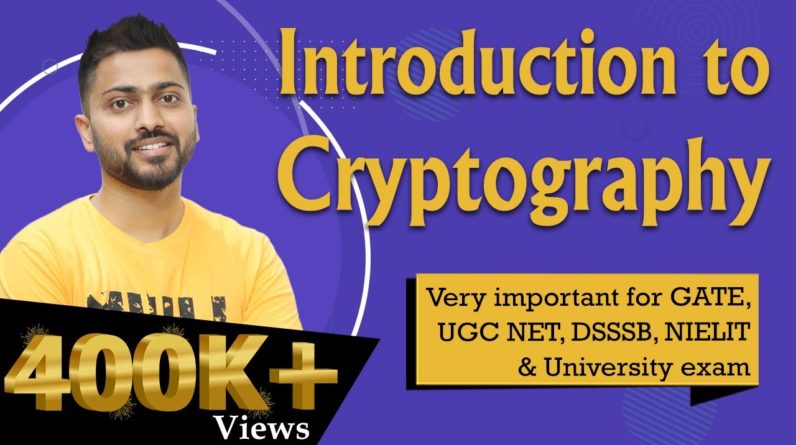
Hello friends, Welcome to Gate Smashers The topic is cryptography. Cryptography is such a technique through which we can convert plain text to cipher text. And cipher text is converted to plain text again. Now you must be thinking the meaning of plain text and cipher text. Plain text is a message, a normal ,message that anyone can read and understand. That what is written in this message. But cipher text is such a message. We can say a secret message. That anyone can read but cannot understand. Meaning the message can be seen. But what is written, the meaning of that. That can never be understood. So why do we convert from plain text to cipher text. We use cryptography to achieve confidentiality. Confidentiality. When we talk about network security. There is one important concept in network security. Of CIA. Confidentiality, Intergrity, and Availability. Intergrity, and Availability. Now the C in CIA is . confidentiality Confidentiality means. What we understand from confidentiality that no one could take my message.
No one should take my message. Meaning if I am sending a message from here. To another receiver. Let's say receiver is sitting somewhere else. Receiver is sitting 1000km away. Now someone is taking my message on the way. He is trying to hack my message in an unauthorised way. But it does not mean that your confidentiality is breached.Confidentiality becomes zero. No. Anyone can take the message. Because what is internet On internet all the devices are connected in a vulnerable manner. Vulnerable means that any person with some knowledge. If he knows the
skill of .
Hacking He can
take your packet. But taking the packet does not mean.Taking the data does not mean. That he can read the data. If the person can also read the data.Understand that. Then you can say confidentiality zero. But if on the way any person trace your packet. Trace does not means that he will understand what is written in the packet. So that is the meaning of confidentiality. Now we are talking that the sender has to send a plain text. Plain text means a normal message that anyone can read. It is a normal message. Now if send that message to receiver. There is no dedicated wire here. We don't have a dedicated wire on internet. Let's say I have to send a message from India to California.Send an email.
So is there a dedicated line from India to california. A dedicated link.No.We are using internet. Meaning when the message exits our machine. On which router, on which node does it go. Meaning this channel, this medium is unsecure. It is . unsecure So an unsecure medium, unsecure channel.We are sending a message on. Any unauthorized person can take that message. So there is no problem of confidentiality here. It can take any . message But if we send that message as plain text. Anyone can read that message. Understand it. But we don't want this. For that we use cryptography. What do we do. Sender, before sending the plain text use encryption method. In encryption we use many algorithms. I will tell you about that algorithms. What do these algorithms do. The most important part here is key. They use a key.Lock, the lock that we put in our house. What is that lock It get locks, and get opened with a key. So that is the key. They will lock with this key. After applying the lock. It becomes cipher text.Cipher text is a secret message which nobody can read.

No one can understand. When we will send that message on this channel. On this unsecured channel.If we send. Then anyone can take that on the way. But that M is not M. That M has become M'.Because we are not sending M as it is. Not sending plain text as it is. We are sending after converting into cipher text. So M becomes .Let's say M'. So the unauthorized person that is reading this on the way. He thinks that sender is sending M'. But we are sending M. And as the message reaches receiver. Receiver will decrypt that message. Because when we are saying that no one can understand the message So how will the receiver understand it So the receiver has to decrypt the message. Decrypt means convert M' to M again. Meaning convert cipher text to plain text. So sender does encryption Receiver does decryption And after decrypting he will read plain text. So along the way the unauthorized user will think it is M' But it is M. So cryptography is not a new term.
Although it is becoming very popular. Because if we talk about
network security If we talk about
network security or cyber security in today's time. It is very popular. But it does not mean that cryptography is used in today's time. Cryptography started at the time of Caesar. King of Rome was Caesar. He used a technique called caesar's cipher And through it if he talked to another king.
So they used to encode the message in such a way that no one could encode that message. But after attacking the message carrier. Anyone could take the message. But it does not mean that they could read the message They have to decrypt to read that message.And for decrypting we need a key And he would not have that key. That is called cryptography Or you can say encryption. And how do we achieve confidentiality. Through encryption method Here we have an important concept That we use cryptography in two ways. Symmetric
and asymmetric. Symmetric and asymmetric
means of same
Symmetric key Meaning with the key used for encryption. With the same key it will decrypt Like same, the lock that we use at home. With the key we closed the lock. If I take my neighbours key and unlock it.So anyone can unlock it. No.With the key used to lock. With the same key we will unlock That is the symmetric key. Asymmetric means. We will use two keys.
With one key we will lock. And with some another key we will unlock. We will see about this in detail This is just the introduction of cryptography This is very important for UGC net and GATE exam. Because many questions are asked on cryptography in that. So that is the basic introduction. Then we will see symmetric and asymmetric key. Thank you..




